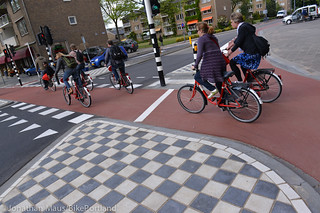
Den Bosch, and it’s paying off in more ways than one.
(Photo © J. Maus/BikePortland)
This is part of ongoing coverage of the Green Lane Project/Bikes Belong Netherlands Study Tour.
‘Lekker Fietsen’ is a promotional slogan used by ‘s-Hertogenbosch, a town about 60 miles south of Amsterdam. It means “Nice Cycling” and today we found out there’s plenty of that in this charming town of 142,000 people. Den Bosch, as its known locally, is one of the Netherlands’ up-and-coming cycling cities. In fact, it currently holds the title of Cycling City of the Year as awarded by the Dutch Cyclists’ Union.
From a stunning roundabout with two-way bicycle traffic (seriously!) to a nifty bike theft prevention campaign, Den Bosch is full of inspiring bicycle innovations. After falling behind other Dutch cities, they launched a focused effort in to increase cycling in 2009 and it seems to be paying off. Streets in their city center are teeming with bikes and economic vitality (while cars are nowhere in sight) and their bicycle mode is growing. Between 2009 and 2011, their percentage of daily trips made by bicycle went up 4 points, from 33 to 37 percent. They’re the only city in the Netherlands that has seen such an increase in recent years.
Today we got a rundown of their latest programs and projects from one of the city’s traffic engineers, Arnold Bongers. Bongers shared some of their work on cycling and then led us on a bike tour through town.
Like all other Dutch towns, Den Bosch’s approach to cycle planning follows five core principles: coherence, directness, attractiveness, safety and comfort. But unlike other places we’ve visited and heard about Den Bosch is going above and beyond — both in promoting cycling to the public and in grabbing opportunities to do bold projects.
Cycle Streets
“It’s really cutting-edge. They’re using user perception to drive function.”
— Zach Vanderkooy, Bikes Belong
Take their concept of “cycle streets” for instance. They’ve taken a standard side road (adjacent to a neighborhood arterial) and turned it into a de facto cycle track with one major difference — people are allowed to drive on it. Bongers and his colleagues used red asphalt (typically used on cycle tracks) and made it look like a cycle track. The street is narrow and traffic-calmed so people driving on it don’t feel like going fast. Prior to its conversion to a cycle street, Bongers said riders would sometimes scoot over and make room for drivers who wanted to pass. Now the idea is that people on bikes take the lane. “The cyclist has to feel strong and stay on their bicycle in the middle of the street,” he said.
Zach Vanderkooy with Bikes Belong, who’s on his ninth study tour in the Netherlands, said this is “pure psychology.” “It’s really cutting-edge. They’re using user perception to drive function. If you’re driving on this you feel uncomfortable.”
Another cool thing about the cycle streets is that since the city didn’t have to remove any auto parking the adjacent residents didn’t resist the project at all.
A roundabout with two-way bicycle traffic
A few blocks away we then came to perhaps the most jaw-dropping engineering feat I’ll see the entire trip: a roundabout with two-way bicycle traffic. Think about that for a minute. Roundabouts are already somewhat notorious for the tricky crossings they create for people on bikes. Now add a stream of people coming in the opposite direction. This design was motivated by a desire to avoid delays at all costs — especially for people riding bicycles.
This two-way bicycle roundabout employs some of the standard Dutch intersection treatments. People cross each other’s paths at right angles and the folks in cars are looking directly at the bicycle path as they approach it (and are thus much less likely to say, “I never saw him!”). They make liberal use of paint, shark’s teeth (for yielding), signage, and so on.
The intersection gets moderate levels of traffic and while we observed it everything seemed to work well. However, Bongers acknowledged that their two-way roundabouts (they have several) have a higher collision rate. “There’s a high level of accidents,” he said, “more than I would like; but not more than before when this intersection had traffic signals.”
See what it’s like to ride around the intersection in the video below:
Park and Ride
The next innovative project we learned about was a park and ride station (“transferia”) situated two kilometers outside the Den Bosch city center. Bongers said the City wanted to limit the number of private cars in their compact and charming downtown district, so they built an auto parking lot a bit further out. For just $2 Euros a day, people can park their cars an then hop on a bus (for free) for a quick ride into downtown. They can also grab a free rental bike if they’d prefer to cycle the two kilometers into town (and yes there a separated path the entire way).
While reducing the number of cars in the city center (which they want to preserve for people instead), the Park and Ride has also had an unintended impact. It turns out that older folks who live in the suburbs don’t like to drive on downtown streets. Word has spread among senior citizens and now people are shopping and visiting downtown Den Bosch specifically because this park and ride exists. Put another way, this park and ride makes Den Bosch a more attractive city to shoppers who don’t want the hassle and expense of driving and parking in the cramped downtown environment.
Security “surveillants”
To help take a bite out of stolen bike crime, Bongers and his colleagues have equipped a group of workers they call “surveillants” to monitor theft hot spots. The workers are recruited from work programs run by social service organizations. They monitor bike parking areas in bright reflective vests. They have no authority to issue tickets, but the visibility alone is a huge theft deterrent. They also use handheld scanners to look up registration numbers and then check them against a national database. If a bike comes up as stolen, they call in the police to do the dirty work. Bongers said they work with 10 surveillants and the cost of the program is only $10,000 per year (the workers are paid by the social service orgs). Since the program started bike theft is down by 30%.
World class bike parking
Den Bosch offers truly luxurious bike parking services. There are several bike parking garages around town. When you arrive at one of them you are welcomed by a friendly attendant who proceeds to strap a claim tag to your bike. It’s that easy. The service is free so you just walk in and walk out. The garages were clean and well lit and buzzing with activity. We watched as shoppers came in with bags full of items just purchased in local shops. In addition to bicycles, you can also grab a stroller (free) or fill up your electric bike via their charging stations.
Market Square
At the center of Den Bosch is Market Square, a grand plaza teeming with life. But it wasn’t always like that. In the 1970s cars dominated the square. While they got cars out of the square in the 1990s, people weren’t allowed to ride bicycles through it. That all changed in 2009 when the city decided to reverse the policy. Bongers said the change wasn’t easy. They had to convince the business owners and the police that it wouldn’t be a problem.
Bongers said bicycle access through the square was an important link in the system. He also wanted the 12,000 people who live on the square to be able to ride their bikes all the way to their front doors. “We were convinced they could share the space.”
It turns out Bongers was right. As you can see in the photos below, even with crowds and mixing of biking and walking, Market Square is a huge success…
You’re also allowed to ride on the side streets that lead to the square…
Overall, I was really impressed by Den Bosch. The bike infrastructure was so pristine, spot-on, and consistent, I felt like I was riding around inside a Dutch bicycle planning textbook. At the end of his presentation today, Bongers summed up the approach that has served him and his colleagues so well: “Have courage, grab opportunities, don’t fight the car, quality counts, have high ambitions, and think positively.”
— See a lot more photos of the excellent cycling in ‘s-Hertogenbosch in the gallery.

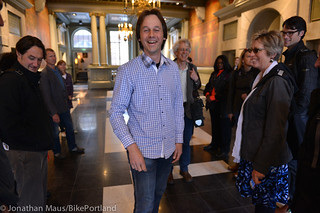
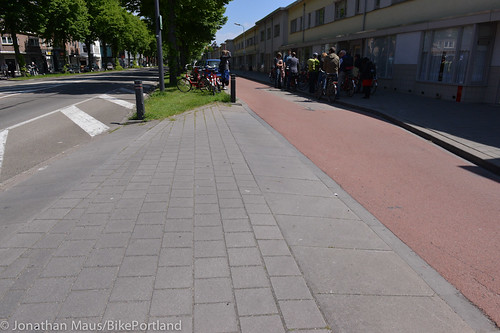

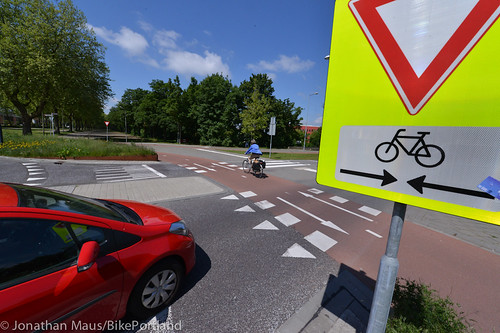
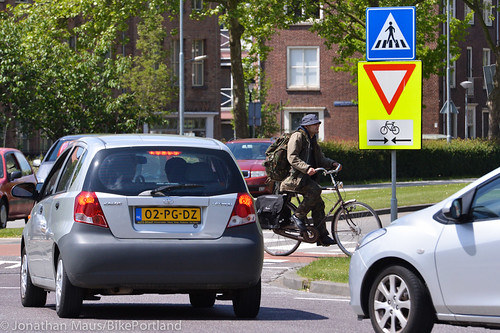
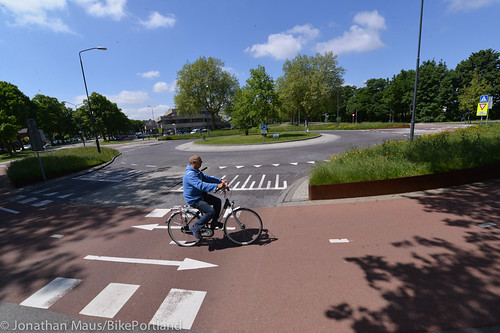

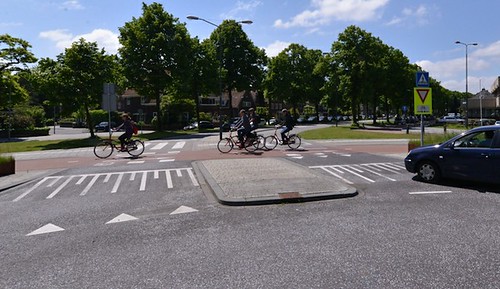

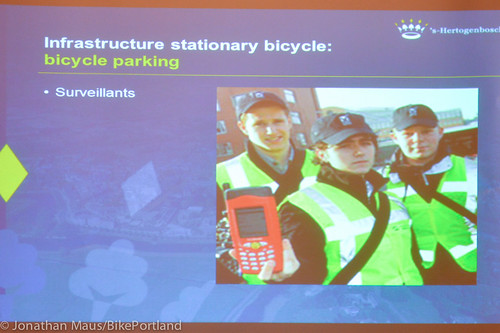
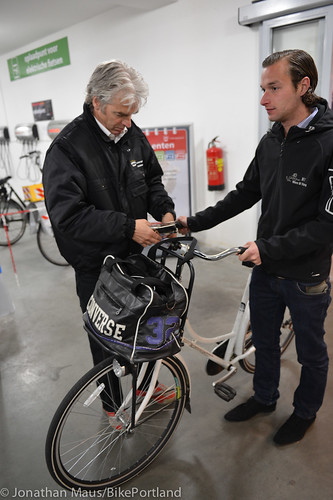
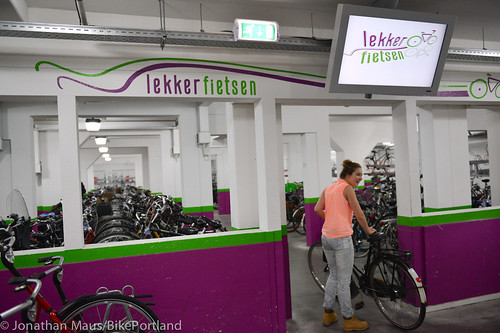
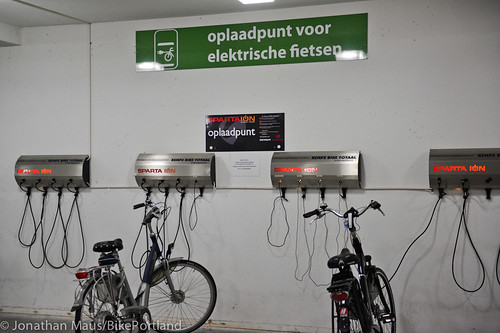
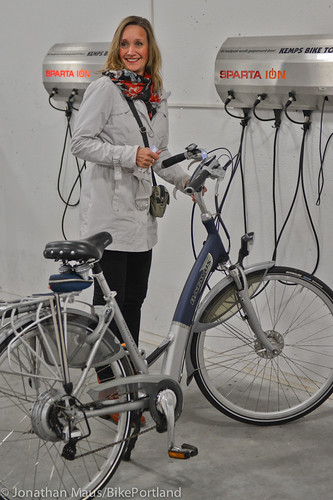
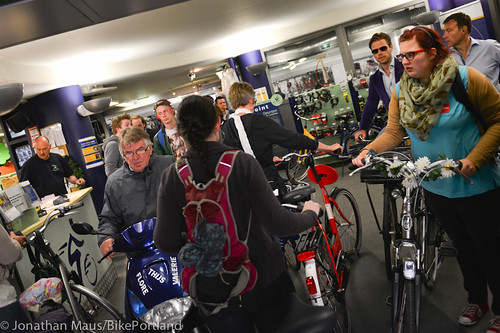

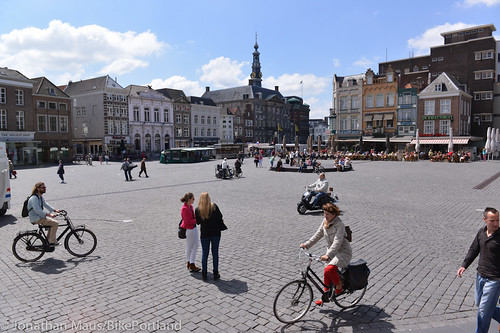
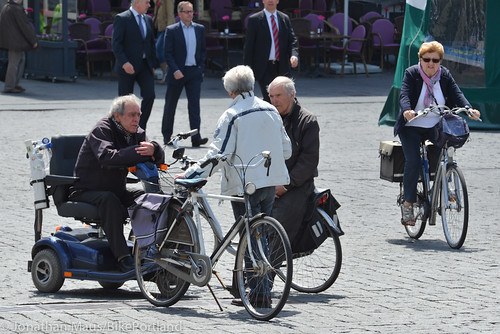
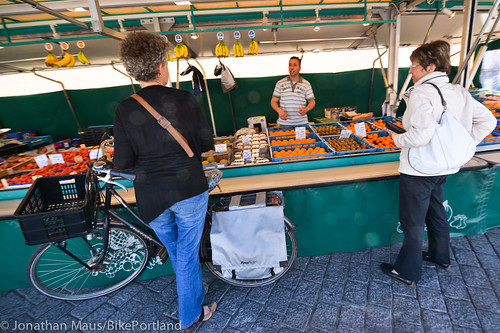

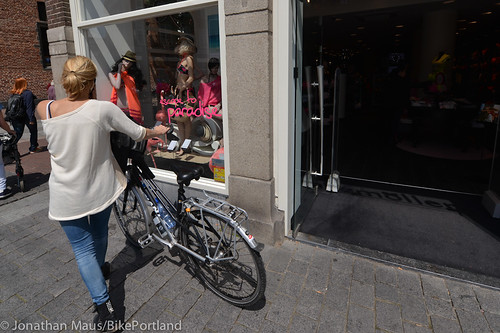
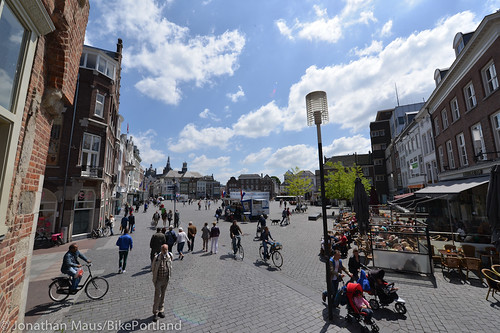
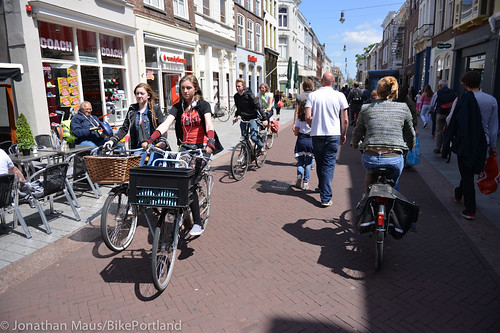


Thanks for reading.
BikePortland has served this community with independent community journalism since 2005. We rely on subscriptions from readers like you to survive. Your financial support is vital in keeping this valuable resource alive and well.
Please subscribe today to strengthen and expand our work.
Nice job! I will have to visit ‘s-Hertogenbosch during my next visit. (Its been 10+ years since I passed through there and back then there was no reason to stop on the way to Maastricht, etc.)
Vancouver (WA), as a similarly sized city could learn a lot from them.
Lekker Fietsen – uses my two favorite Dutch words…though I like the other common translation of Lekker = Delicious. Delicious Bikes. 😉
“Lekker” is a Dutch word with numerous meanings embedded into it. It also includes the concept of wonderfulness’, pleasure and sheer delight.
It would b nice to know what is behind his statement “don’t fight the car” — compare to Portland’s “Disincintives to the Automobile” memo (covered here) http://bikeportland.org/2013/02/15/over-40-years-ago-city-of-portland-memo-outlined-disincentives-to-the-automobile-82960
In ‘s-Hertogenbosch we want to get more people cycling (and using Public Transport). We do that by creating a positive bicycle climate. The bicycle is good for everybody. But we don’t emphasize on fighting the car. If you want to drive your car to our city centre, you can. But it takes a long time, it’s expensive to park and the number of parkimng places are limited. That by itself is a good foundation for a bicycle friendly climate.
Lekker Fietsen does the rest.
Thanks for your response.
Making parking expensive and making it hard to drive downtown would get you branded a crazy radical in America. You are very lucky to live in a civilized country. I am trying to puzzle out how to get us from here to there, and I’d love to do it without fighting, just by the application of common sense, but it is not obvious how to proceed.
It seems that on the path to where you are today, there was some more confrontation: http://en.wikipedia.org/wiki/Provo_(movement)
I’d love to be able to skip that phase, but I’m not convinced it is possible.
My guess about about “don’t fight the car” is that bikes are better than cars in the right environment. That by optimizing cities for bike and foot traffic, everyday shopping and livability increases. Cars may still have a function, but seen as cumbersome and expensive.
In other words focus on making cities more livable.
“Don’t fight the car” is exactly what it sounds. Those who advocate mandatory segregation of cyclists are enablers of motoring.
But does advocating market pricing for on-street parking, or citywide 20 MPH by default, or making the bicycle boulevards local-access-only for cars, count as fighting the car?
If you slow traffic to 20 mph there is no need for fancy schmancy cycle tracks. Driving is a shitty thing and like a lot of shitty things in our society we force this behaviour on the bottom socio-economic rungs. Cycle tracks for the inner city elite and a few reversed stop signs and fading paint splotches for the peripheral dispossessed.
You haven’t caught the gist of this at all. Don’t fight the motorist means that it’s ridiculous to waste energy by engaging in a fight of ‘them vs. us’. Instead, make such excellent facilities for bikes, that people will like to use them without any further incentive. Of course you can’t drive thousands of cars into Den Bosch center every hour. So, they provided for good and cheap parking facilities outside the center. Car drivers are not the enemy, they’re potential cyclists.
That ‘side road’ is part of the former boulevard. Most boulevards have side roads. Streets called boulevards, does not make them boulevards. There is an actual form for an actual ‘boulevard’, which mostly only still exist in Europe. The main road goes through and has priority, the side road is for all the friction of parking and accessing local businesses. What being done is simply reprioritizing the right of way uses – a very, very wide right of way. Not something we have here.
The 2-way cycle track at the modern roundabout also has a raised crossing (speed bump) to encourage slowing. If the cycle track is placed near the same location as the pedestrian crossing, the motorist should already be looking both ways. They have two flavors of this treatment. In urban areas the cars yield to cyclists. In rural areas the cyclists yeild to autos. I don’t agree with permitting mopeds on cycle tracks, but it seems to be a wide spread practice.
The “don’t fight the car” and “beat it at its own game” statements seems to warrant a whole other article. How do you do that here when you’re dealing with people who refuse to compromise on giving up any of their car infrastructure?
Different cultures, different place.
That’s a very bad and easy answer. If you want to do it the harder but better way: set op guarded parking lots around the center of a town. Set up a regular bus service at 10- minutes intervals for say 2 dollars. AND provide free bikes for ‘rent’, and safe, direct and signposted bicycle paths straight to town center. Make town center car free. Start with just one city, and see how shopping there explodes. Takes some thinking to get it right, but it most certainly will work. This example is not proof it only works in Utopia, it will work most anywhere.
Hope you managed to get a Bossche bol while you were in ‘s-Hertogenbosch. I’m totally Bongers for them. (That’s the best last name ever.)
What I love about it there is that there are almost no stop signs anywhere. I tried counting the number of stops signs I saw in Amsterdam when I lived there. I never got higher than 2.
Go to the worst bicycling city in The Netherlands. Then you will be impressed. You are missing the point. They all have the same infrastructure.